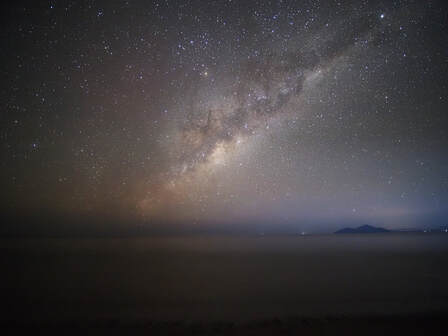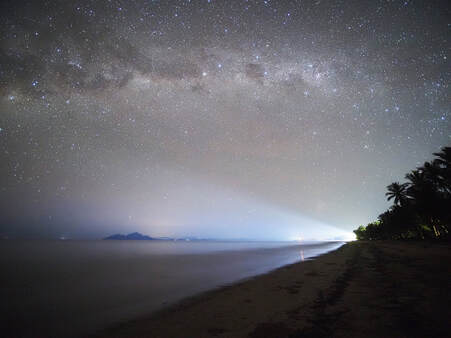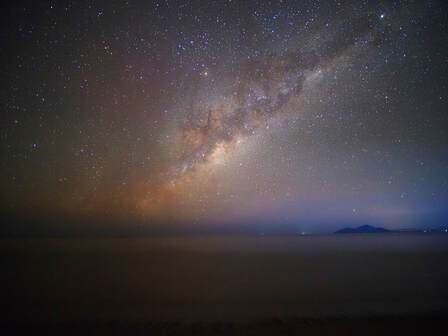Many of you will know that my other passion is photography, and I actually use many of my photos for my book covers.
When we were at Mission Beach last winter, there was no moon on the night we arrived, and I wanted to try out some more astrophotography settings. The photos below, one of which is also on my home page, were the result.
When we were at Mission Beach last winter, there was no moon on the night we arrived, and I wanted to try out some more astrophotography settings. The photos below, one of which is also on my home page, were the result.
Taking them proved an adventure!
Our caravan was about three hundred metres away from the beach, and the night was pitch dark.
I decided to be brave, and head over by myself through the rainforest as Ian was engrossed in a book. I did ask my brave man to come and check on me if I wasn’t back in 45 minutes, and the intrepid photographer set off to the tropical deserted (I hoped) beach.
I had a small LED lamp with me so that I could turn it on to see the camera settings as I experimented.
Did I tell you it was dark? It was midnight black!
I walked through the forest, thinking of deadly taipans, and breathed a sigh of relief when I reached the sand.
It was so dark I couldn’t see how high the water was, but crocodiles were in the back of my mind, and I hoped that was where they stayed.
All I could hear was the swish of the water as the tide pushed up onto the sand.
I played with the settings of my camera and had no success. I’d read up on it all before I left the caravan, and knew the correct settings.
Choose a low aperture between f/2.8 and f/4.
Use manual focus.
Set white balance to Kelvin… I love the name of that setting
Set exposure length between 15 and 30 seconds.
Select a high ISO between 400 and 1600 (or more) … I love more!
However, no matter what I did, the photos were bland, and I knew there was one setting I hadn’t been able to find.
With my lamp on briefly, I focused and played with the settings to no avail, and the time flew by.
I was about to give up when I heard a noise… was that a crocodile scuffling in the sand near me? A huge crocodile looking for a late snack?
Of course, I dropped the lamp as I hurriedly tried to pack up my tripod, and camera with shaking fingers.
All was silent until suddenly an unfamiliar voice said. ‘Hello.’
First off, relief. Crocodiles don’t say hello.
But remember, I’m on a deserted beach, in pitch dark, alone except for a vivid crime writer’s imagination.
Suddenly a light flashed on to reveal, another woman with a camera and tripod, and a huge lens!
Another photographer had seen my lamp from way down the beach and she had come looking. Selina had taken the most magnificent photo with her Canon camera.
An hour had now passed and I had forgotten all about my 45-minute return as we discussed various settings, and she Googled my problem on her phone to no avail.
Eventually, we stumbled on the solution! It was an old-fashioned manual setting and not part of the digital menu.
So, I managed to snap the spectacular photo that I had set out to take.
Selina and I were about to pack up, when my worried husband arrived in the dark, checking to see if I had encountered a crocodile!
“Thank you, dear,” I assured him.
Once more, I had survived to write many more books, and take many more photos.
Our caravan was about three hundred metres away from the beach, and the night was pitch dark.
I decided to be brave, and head over by myself through the rainforest as Ian was engrossed in a book. I did ask my brave man to come and check on me if I wasn’t back in 45 minutes, and the intrepid photographer set off to the tropical deserted (I hoped) beach.
I had a small LED lamp with me so that I could turn it on to see the camera settings as I experimented.
Did I tell you it was dark? It was midnight black!
I walked through the forest, thinking of deadly taipans, and breathed a sigh of relief when I reached the sand.
It was so dark I couldn’t see how high the water was, but crocodiles were in the back of my mind, and I hoped that was where they stayed.
All I could hear was the swish of the water as the tide pushed up onto the sand.
I played with the settings of my camera and had no success. I’d read up on it all before I left the caravan, and knew the correct settings.
Choose a low aperture between f/2.8 and f/4.
Use manual focus.
Set white balance to Kelvin… I love the name of that setting
Set exposure length between 15 and 30 seconds.
Select a high ISO between 400 and 1600 (or more) … I love more!
However, no matter what I did, the photos were bland, and I knew there was one setting I hadn’t been able to find.
With my lamp on briefly, I focused and played with the settings to no avail, and the time flew by.
I was about to give up when I heard a noise… was that a crocodile scuffling in the sand near me? A huge crocodile looking for a late snack?
Of course, I dropped the lamp as I hurriedly tried to pack up my tripod, and camera with shaking fingers.
All was silent until suddenly an unfamiliar voice said. ‘Hello.’
First off, relief. Crocodiles don’t say hello.
But remember, I’m on a deserted beach, in pitch dark, alone except for a vivid crime writer’s imagination.
Suddenly a light flashed on to reveal, another woman with a camera and tripod, and a huge lens!
Another photographer had seen my lamp from way down the beach and she had come looking. Selina had taken the most magnificent photo with her Canon camera.
An hour had now passed and I had forgotten all about my 45-minute return as we discussed various settings, and she Googled my problem on her phone to no avail.
Eventually, we stumbled on the solution! It was an old-fashioned manual setting and not part of the digital menu.
So, I managed to snap the spectacular photo that I had set out to take.
Selina and I were about to pack up, when my worried husband arrived in the dark, checking to see if I had encountered a crocodile!
“Thank you, dear,” I assured him.
Once more, I had survived to write many more books, and take many more photos.


